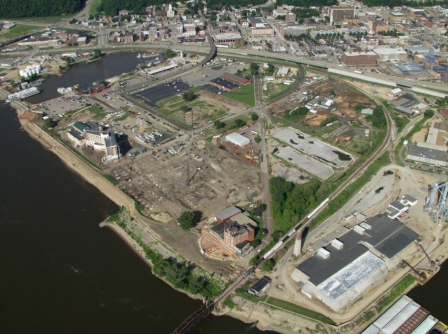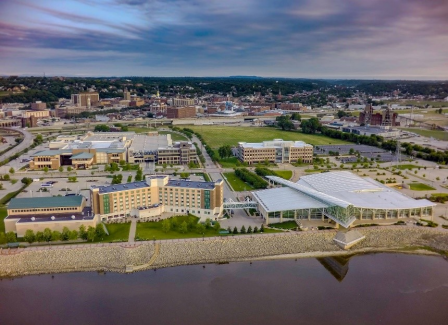News Releases from Region 07
Dubuque, Iowa’s North Port Revitalization Highlighted by EPA as a Transformative Brownfields Cleanup
Environmental News
FOR IMMEDIATE RELEASE
 Dubuque’s North Port during the very early stages of demolition and cleanup of former industrial sites. (Credit: City of Dubuque).(Lenexa, Kan., July 13, 2020) - Dubuque, Iowa’s North Port Revitalization initiative is being highlighted today by the U.S. Environmental Protection Agency (EPA). The initiative is one of several marquee Brownfields redevelopment projects in Dubuque that continue to receive national recognition.
Dubuque’s North Port during the very early stages of demolition and cleanup of former industrial sites. (Credit: City of Dubuque).(Lenexa, Kan., July 13, 2020) - Dubuque, Iowa’s North Port Revitalization initiative is being highlighted today by the U.S. Environmental Protection Agency (EPA). The initiative is one of several marquee Brownfields redevelopment projects in Dubuque that continue to receive national recognition.
This week, EPA is commemorating the Agency’s 50th anniversary by highlighting successful Brownfields revitalization efforts, often in underserved and economically disadvantaged communities.
The city of Dubuque, Iowa, has used brownfields funding for a remarkable turnaround in the North Port area.
“You can’t argue with success. Communities in Iowa, Kansas, Missouri and Nebraska are achieving key land revitalization goals by leveraging EPA’s Brownfields Program,” said EPA Region 7 Administrator Jim Gulliford. “Dubuque’s North Port waterfront revitalization initiative took a contaminated industrial area and turned it into a wonderful business and entertainment destination.”
“Time and time again in Dubuque, EPA Brownfields grants have helped the city and its residents start down the path of impactful redevelopment,” said City of Dubuque Project Manager Steve Sampson Brown. “Many of our Brownfields sites historically had too many unknowns, and private developers had no interest in spending their own money to figure out what contaminants were present on these sites and how to deal with them. Strategic utilization of assessment grant funding has allowed the city and brownfield property owners to define the extent of contamination at these locations and also establish a redevelopment framework that affordably allowed for many of these blighted sites to be redeveloped. Once the extent of the contamination problem was delineated, private developers became willing to get involved.”
 Modest Brownfields grants have leveraged over $500 million of public and private investment to date in Dubuque’s North Port. (Credit: City of Dubuque).“The modest Brownfields grants have now leveraged over half a billion dollars in public and private investment. It has brought educational, recreational, business, and entertainment options to residents and visitors alike,” said City of Dubuque Economic Development Director Jill M. Connors. “We estimate 1 million visitors a year to the North Port. Most importantly, it has reconnected our residents to the river. Dubuque has since made use of nearly a dozen Brownfields grants to transform our downtown, which was first populated in the early 1800s, into a clean, thriving mixed-use asset to our community.”
Modest Brownfields grants have leveraged over $500 million of public and private investment to date in Dubuque’s North Port. (Credit: City of Dubuque).“The modest Brownfields grants have now leveraged over half a billion dollars in public and private investment. It has brought educational, recreational, business, and entertainment options to residents and visitors alike,” said City of Dubuque Economic Development Director Jill M. Connors. “We estimate 1 million visitors a year to the North Port. Most importantly, it has reconnected our residents to the river. Dubuque has since made use of nearly a dozen Brownfields grants to transform our downtown, which was first populated in the early 1800s, into a clean, thriving mixed-use asset to our community.”
“Without redevelopment opportunities, urban and rural communities – even those with deep historic roots – can eventually wither,” said EPA Office of Land and Emergency Management Assistant Administrator Peter Wright. “Brownfields remediation and revitalization supports communities by investing in the redevelopment of existing properties in the community.”
Over the past three years alone, EPA has assessed 6,572 properties, completed cleanups at 638 properties, and made 2,900 properties ready for anticipated reuse. Over this same period, more than 43,000 jobs have been leveraged as a result of Brownfields actions.
Since EPA’s Brownfields Program began in 1995, it has provided nearly $1.6 billion in Brownfields funding to assess and clean up contaminated properties and return blighted properties to productive reuse. EPA’s Brownfields funding has leveraged more than $32.6 billion in cleanup and redevelopment from both public and private sources, which in turn has produced more than 167,000 jobs. This is an average of nine jobs per $100,000 of EPA investment and more than $17 in private funding for each dollar of EPA Brownfields grant funding.
For example, Brownfields grants have been shown to:
- Increase Local Tax Revenue: A study of 48 Brownfields sites found that an estimated $29 million to $97 million in additional local tax revenue was generated in a single year after cleanup. This is two to seven times more than the $12.4 million EPA contributed to the cleanup of these sites.
- Increase Residential Property Values: Another study found that property values of homes near revitalized Brownfields sites increased between 5 and 15% following cleanup.
Background
A Brownfield is a property for which the expansion, redevelopment, or reuse may be complicated by the presence or potential presence of a hazardous substance, pollutant or contaminant. EPA’s Brownfields Program empowers local leadership and communities to transform underused and distressed properties into community assets across America. Brownfields funds assess and cleanup vacant, underused, and potentially contaminated properties so that property can be reused as housing, recreation and open space, health facilities, social services, or commercial sites. There are estimated to be more than 450,000 Brownfields in the United States.
For more information on EPA Region 7 Land Revitalization success stories, maps, and resources, go to: EPA Region 7 Land Revitalization.
Follow us throughout July on Twitter @EPALand for the latest information on what’s happening as “Cleaning Up America’s Land” month continues.
For more on EPA’s 50th Anniversary and how the Agency is protecting America’s waters, land and air, visit: www.epa.gov/50 or follow us on social media using #EPAat50.
# # #
Learn more about EPA Region 7
View all Region 7 news releases
Connect with EPA Region 7 on Facebook: www.facebook.com/eparegion7
Follow us on Twitter: @EPARegion7
